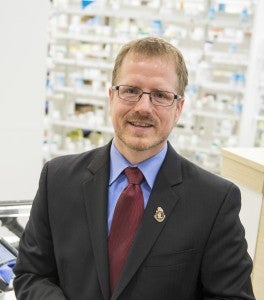FACULTY | Life Saver
Summer 2016
The following is an excerpt from an article that will appear in the Summer issue of QuadAngles.
 Signs of a deadly overdose: respiratory distress, clammy skin, blue lips. As sales of prescription opioid painkillers have climbed 400 percent in the last 15 years in the U.S., overdose deaths from opioids have gone up as well: by 200 percent. In response, police officers are outfitted with lifesaving naloxone, which can reverse the effects of an overdose within minutes; now Clinical Professor Jeffrey Bratberg wants to go a step further: Distribute naloxone from pharmacies to users—and their friends and families.
Signs of a deadly overdose: respiratory distress, clammy skin, blue lips. As sales of prescription opioid painkillers have climbed 400 percent in the last 15 years in the U.S., overdose deaths from opioids have gone up as well: by 200 percent. In response, police officers are outfitted with lifesaving naloxone, which can reverse the effects of an overdose within minutes; now Clinical Professor Jeffrey Bratberg wants to go a step further: Distribute naloxone from pharmacies to users—and their friends and families.
An infectious disease specialist with a focus on public health, Bratberg was researching the role of pharmacists in bioterrorism and natural disaster responses when he learned that Rhode Island had one of the highest rates of fatal overdoses in the country. He teamed up with his colleagues and doctors to develop a program that allows anyone to obtain naloxone from a participating pharmacist, also enlisting student Tara Thomas, Pharm.D. ’13 to create an online training course on overdose signs and recommending addiction treatment centers. Naloxone costs about $100 per kit and is covered in Rhode Island by public and private health insurance.
His idea is gaining traction across the nation. Bratberg is working with researchers at Boston Medical Center on a $1.3 million federal grant to create best practices for naloxone distribution by pharmacists. Skeptics say people will use naloxone as an excuse to continue their drug use without fear of an overdose. Bratberg’s response: “It’s not a moral failing to be a chronic drug user; it’s a disease. Do we lock up people with diabetes because they ate too much sugar? As a society we have a moral obligation to treat people with chronic diseases.’’
Continue reading the Pharmacy Newsletter →
;
 Home
Home Browse
Browse Close
Close Events
Events Maps
Maps Email
Email Brightspace
Brightspace eCampus
eCampus


